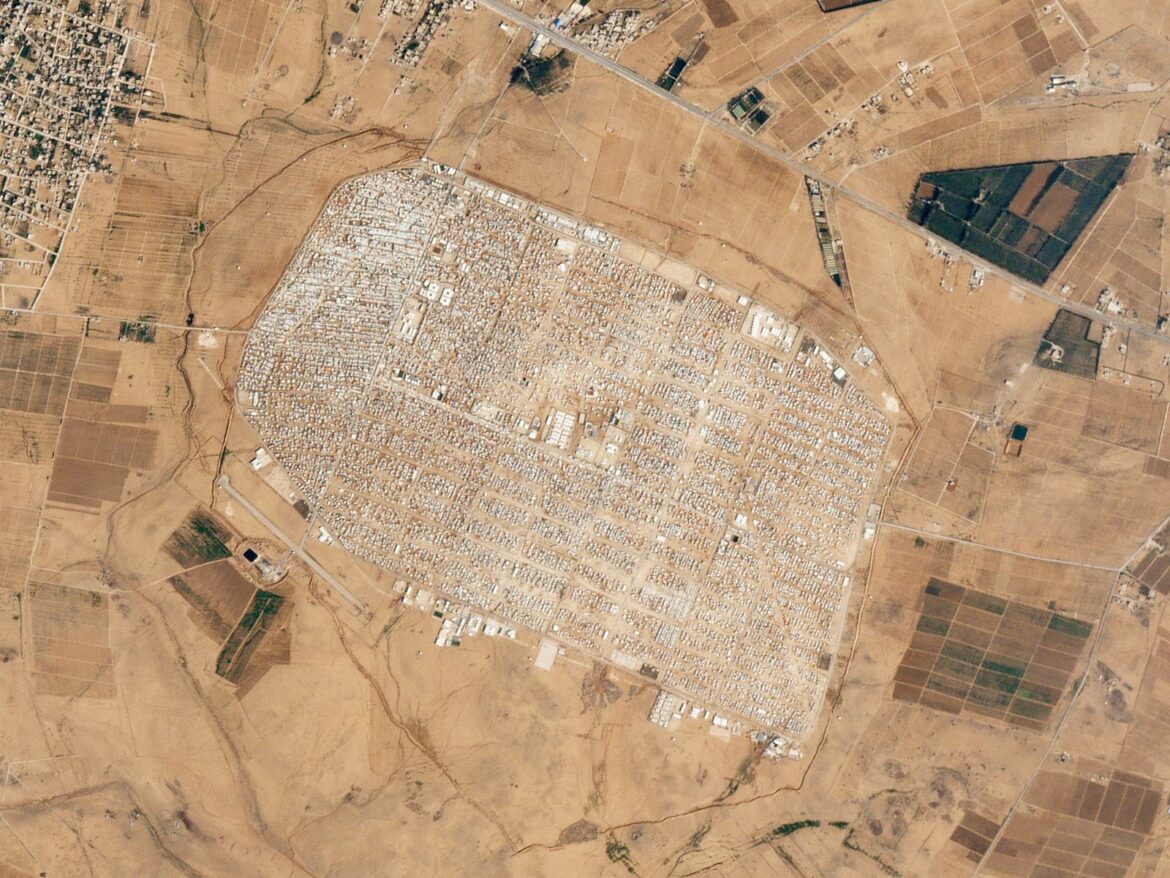In the dry deserts of Jordan, a city of white caravans has taken shape. The Zaatari Camp, otherwise known as the largest refugee camp in the Middle East, stands out prominently in its 5.5 square kilometers of white shelters against the natural dry lands of northern Jordan. Having started with 450 Syrians seeking safety from conflict, the camp has now expanded to almost 80,000 Syrians, including the 20,000 born into the camp. Growing to accommodate for the increase in residents, the camp has transitioned from a collection of tents to an entire makeshift city. While the basic functionality of the Zaatari Camp continues, a lingering uncertainty and a worry of securing permanence in a solution made to be temporary continues to spread among the residents.
Officially opened on July 29th 2012, the camp has grown to account for the basic needs of the Syrian residents through a network of systems across medical, educational, and social fields. The camp currently contains 26,000 prefabricated shelters, 32 schools, 58 community centers, and 8 medical clinics all of which are run under the joint administration of the UNHCR and the Syrian Directorate of Refugee Affairs (SRAD). Within this vast infrastructure, families are provided shelters, children are promised classrooms, and the sick get access to health care. The community centers offer a chance of normalcy in the form of social events, accelerated learning programs and even sports games. The development of these opportunities and systems within the camp strive to encourage self-reliance and resilience among the Syrian residents. Even among the residents themselves, thoughts on the camp’s infrastructure and resources seem to be generally positive, as one resident, Adil Toukan, stated, “Life is stable, in terms of the living conditions, security, and infrastructure.”
Indeed, the residents have attempted to make the most of their lifestyle within the Zaatari Camp, restoring ordinary routines and practices in any possible way. The spirit of entrepreneurship carries the valuable load of Syrian self-determination within the Zaatari Camp as continually proved by the “Shams Elysees,” a self-produced reminder of home. The Shams-Elysees’ a 3km-long street of bustling markets, is a Syrian-run commercial strip with over 3,000 stores containing merchandise from sweets to beauty products and functional businesses like barbershops and phone repair stations. The name, a play on both the famous Champs-Élysées in Paris and the word “Sham,” a reference towards Syria, marks the ties to home that are never forgotten within the camp. The result of this chain of markets is the development of an entire urban subculture springing amongst the temporary infrastructure of the refugee camp — a reminder of the resilience that continues in uncertainty.
Beyond entrepreneurship, the residents of the Zaatari Camp have looked to bring color to their circumstances through artistic approaches. The Jasmine Necklace, a Syrian artists collective within the camp, strives to comfort the refugee youth within the camp through creative expression and public art projects. A theater company, ‘Mark of Hope’ also stands out amidst the discomfort of life within the camp. This company, created by Hamzah Hussein, focuses on uplifting refugee children with disabilities through theatrical productions. Empowering the youth of the Zaatari Camp through artistic expression highlights the population’s devotion to providing a future for their youth regardless of their confusing circumstances.
Despite the efforts by both the administrators and residents to develop lasting functional systems, serious questions of the residents’ futures and freedom continue to call within the camp. At the forefront of these questions, a lack of higher education and sustainable work takes the lead. With only four percent of the working-age population within the camp holding work permits, opportunities for stable and risk-free work are incredibly rare. This limitation holds especially strong in the hearts of parents who often watch their children leave their education behind to join the unstable workforce and support their family. However, U.N. interviews with young refugees show that the dreams of these children continue to form despite the limitations of the camp’s higher education, as young Ghina expresses her hope of becoming a policewoman and teenage Muhammad states his dream of becoming a doctor. Regardless of the persistence of their children’s dreams, parents have little choice but to shrug at their children’s questions about a future beyond the confines of the camp.
The result is a state of limbo. The residents of the Zaatari camp, only 12 kilometers away from their home country, continue to live neither in a home nor unfamiliar territory. They’ve done everything to make the Zaatari Camp their own but it cannot sustain the dreams of their children nor guarantee their futures. With the 12th anniversary of the Zaatari Camp approaching, it serves as a reminder of the ongoing challenges faced by those who are forced to live without a home, navigating the complexities of finding permanence in a temporary solution.
Edited by Aimee Wang
Yasmine Tujjar is a third-year student at McGill University, pursuing a B.A. in History with minors in Arabic language and Political Science. Her journalistic interests are rooted in her passion for post-conflict research and cross-cultural, interfaith reconciliation.

